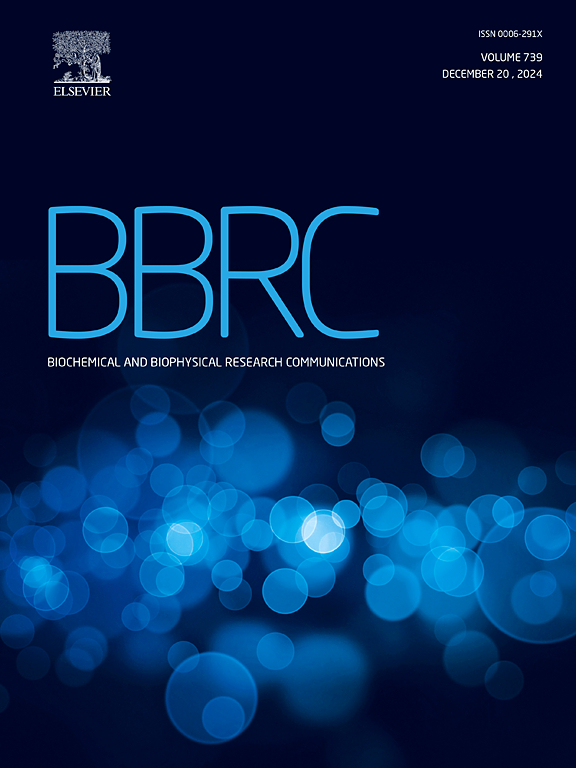The stability of the Opi1p repressor for phospholipid biosynthetic gene expression in Saccharomyces cerevisiae is dependent on its interactions with Scs2p and Ino2p
IF 2.5
3区 生物学
Q3 BIOCHEMISTRY & MOLECULAR BIOLOGY
Biochemical and biophysical research communications
Pub Date : 2024-10-18
DOI:10.1016/j.bbrc.2024.150849
引用次数: 0
Abstract
The yeast Saccharomyces cerevisiae Opi1p negatively regulates phospholipid biosynthetic genes. Under derepressing conditions, Opi1p binds to the endoplasmic reticulum/nuclear membrane with the aid of the membrane protein Scs2p and phosphatidic acids under derepressing conditions. Under repressing conditions, it enters the nucleus to inhibit the positive transcription factors Ino2p and Ino4p. While the spatial regulation of Opi1p is understood, the regulation of its abundance remains unclear. We investigated the role of Scs2p and Ino2p in Opi1p stability by overexpressing these proteins in yeast cells. Opi1p was stable in the presence of Scs2p, but mutations in residues required for interaction with Scs2p caused Opi1p unstable. Even in the absence of Scs2p, Opi1p remained stable in the strain having a mutation to increase phosphatidic acid levels. Conversely, overproduction of Ino2p reduced Opi1p stability, whereas a mutant Ino2p that cannot interact with Opi1p did not. Additionally, Opi1p was stable in strains lacking Ino2p or with a mutated Ino2p-binding domain. These findings suggest that regulation, adding another layer to the regulation of phospholipid biosynthetic gene expression by Opi1p.
在酿酒酵母中,Opi1p抑制磷脂生物合成基因表达的稳定性取决于它与Scs2p和Ino2p的相互作用。
酵母菌 Opi1p 负向调节磷脂生物合成基因。在去抑制条件下,Opi1p 借助膜蛋白 Scs2p 和磷脂酸与内质网/核膜结合。在抑制条件下,它进入细胞核抑制正转录因子 Ino2p 和 Ino4p。虽然人们了解 Opi1p 的空间调控,但对其丰度的调控仍不清楚。我们通过在酵母细胞中过表达 Scs2p 和 Ino2p,研究了这两种蛋白在 Opi1p 稳定性中的作用。在有 Scs2p 存在的情况下,Opi1p 是稳定的,但与 Scs2p 相互作用所需的残基突变会导致 Opi1p 不稳定。即使在没有 Scs2p 的情况下,Opi1p 在发生突变以增加磷脂酸含量的菌株中也保持稳定。相反,过量生产 Ino2p 会降低 Opi1p 的稳定性,而不能与 Opi1p 相互作用的突变体 Ino2p 则不会。此外,在缺乏 Ino2p 或 Ino2p 结合域发生突变的菌株中,Opi1p 也很稳定。这些发现表明,Opi1p 对磷脂生物合成基因表达的调控又增加了一层。
本文章由计算机程序翻译,如有差异,请以英文原文为准。
求助全文
约1分钟内获得全文
求助全文
来源期刊
CiteScore
6.10
自引率
0.00%
发文量
1400
审稿时长
14 days
期刊介绍:
Biochemical and Biophysical Research Communications is the premier international journal devoted to the very rapid dissemination of timely and significant experimental results in diverse fields of biological research. The development of the "Breakthroughs and Views" section brings the minireview format to the journal, and issues often contain collections of special interest manuscripts. BBRC is published weekly (52 issues/year).Research Areas now include: Biochemistry; biophysics; cell biology; developmental biology; immunology
; molecular biology; neurobiology; plant biology and proteomics

 求助内容:
求助内容: 应助结果提醒方式:
应助结果提醒方式:


